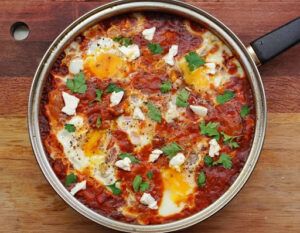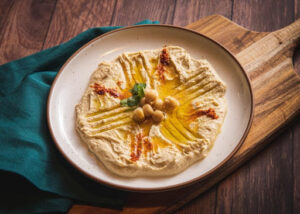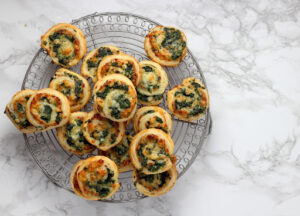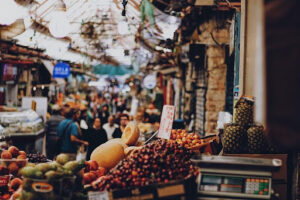The food in Israel is delicious and famous for its creative recipes and flavors. Israeli food is packed with nutrition and is one of the healthiest cuisines in the world. The country is considered the vegan food hub of the world as cities like Tel Aviv have over 400 vegetarian and vegan restaurants. Modern Israeli cuisines represent the culinary fashion of traditional Jew foods.
Because of the geographical location of Israel, the cuisine is heavily influenced by Mediterranean, Middle Eastern, European and African cuisines. The diverse culinary and cultural influences make Israeli foods one of the world’s most delicious and healthy.
While you may not find it necessary to learn Hebrew to enjoy such delicious foods in Israel, knowing the language will help you significantly when ordering and enquiring about the cuisines.
Let’s discuss some of the best foods and their recipes to help you understand which foods are convenient to make.

-
Chakchouka (Shakshouka)
Chakchouka is an Israeli and Tunisian dish made from pepper, spices, onions, eggs, and tomatoes. You can also make this with Feta. The dish is typically consumed for lunch or breakfast, but you can eat it anytime you like.
This is one of the easier dishes to make as the ingredients can be commonly found. The dish is similar to “Menemen,” a Turkish dish and “Huevos Rancheros,” a Latin American dish.
Ingredients
You’ll need a tablespoon oil, one-fourth cup of chopped onions, and sliced bell peppers for a single serving. Later add in one-half minced garlic for extra taste,and one-half cup of chopped tomatoes. Next, add one-fourth teaspoon ground cumin, salt, paprika, finely chopped hot chilli pepper, and one egg.
How to Cook
Begin with heating the olive in a skillet over medium heat and stir fry the bell peppers, onions, and garlic until the vegetables have softened and the onions have turned translucent. The process takes about 5 minutes.
Bring the cumin, tomatoes, paprika, salt, chili pepper into a bowl and mix them briefly. Afterward, pour the tomato mixture into a skillet and stir the combination. Simmer until tomato juice cooks off for about 10 minutes and make another mixture consisting of eggs and tomato.
Start with cracking the eggs into indentations and then covering the skillet to let the eggs cook for about 5 minutes until they’re firm.
Your Chakchouka (Shakshouka) is now ready.
Pro tip: Learning Hebrew will help you read any instructions or cooking guides in the language, should you require additional assistance.

-
Hummus (Chummus)
Middle Eastern Chummus is different from its American counterpart. One might say it’s even tastier as well. This dish is delicate and creamy in taste compared to the overpowered thick and pasty garlic version. The eastern fresh and warm whole meal comes together in this dish, and you can even put some fresh olive oil on it. The dish can be consumed with raw onion slices and pita.
Ingredients
The first thing you’ll need is one-third cup of both soaked and dry garbanzo beans. Add a pinch of soda, one tablespoon of extra-virgin oil, and one and a half tablespoons of tahini paste.
Afterward, you’ll require half a tablespoon of lemon juice for extra taste, a pinch of minced clove garlic, and a one-eighth tablespoon of ground cumin. Lastly, add some salt and drizzle virgin oil.
How to Cook
Fill a pot with water and add the garbanzo beans. Add some baking soda and boil the beans on medium heat until they turn soft. This could take about 2 hours. Drain the beans and reserve the water as you’ll need it later.
You also need to reserve some of the beans for garnishing. Transfer the rest of the beans to a blender and continue blending until it turns smooth. Add half a cup of olive oil and the reserved water if needed.
Lastly, add the tahini and blend it with lemon juice, salt, cumin, and garlic. Spread the hummus into a flat dish with reserved beans and drizzle the olive oil over it.
If you’re finding it difficult to understand any of the labels on food products, you can start learning Hebrew online. This will help you communicate and read Hebrew better.

-
Cheese Bourekas
Cheese Bourekas are filled with cheese and are a Middle-Eastern version of the puff pastry. While you can fill these with spinach, feta mixture, and mashed potatoes, they are mainly eaten with cheese, salad, olives, and yogurt for breakfast.
Ingredients
You’ll need half an egg with two and a half tablespoons of shredded mozzarella cheese. Add some dried parsley, a pinch of garlic powder, onion powder, black pepper, and salt. You can also use packaged and frozen puff pastries. The final ingredients are half a tablespoon of sesame seeds and one-sixth tablespoon of water.
How to Cook
Heat your oven for up to 175 degrees celsius and grease a baking sheet. Beat an egg in a medium-sized bowl, mix cheese, and season garlic powder, salt, onion powder, pepper, and parsley. Make a lightly floured surface where you’ll cut the puff pastry into equal squares.
Once done, beat the egg with some water in a small-sized bowl. Place a tablespoon of cheese mixture in the center of the squares you created and fold the pastry sealing all of the fillings with a fork.
Transfer the pastry to the baking sheet and brush the egg wash, sprinkling sesame seeds in the end. You can bake these for around 30 minutes in the oven until they turn golden brown.

Study Hebrew at Home!
If you’re planning to visit Israel soon, visit Ulpan-Or today to start your Hebrew learning sessions. Our beginner Hebrew courses will help you learn Hebrew online with native teachers from the very comfort of your home. We also offer a vast range of Hebrew magazines and books to promote Hebrew self-study. Get in touch today for more information.


